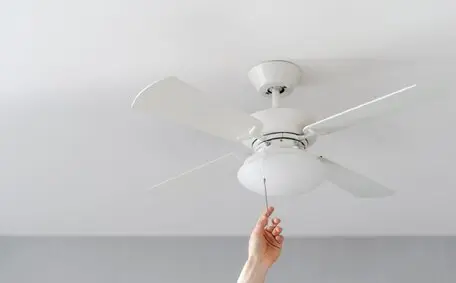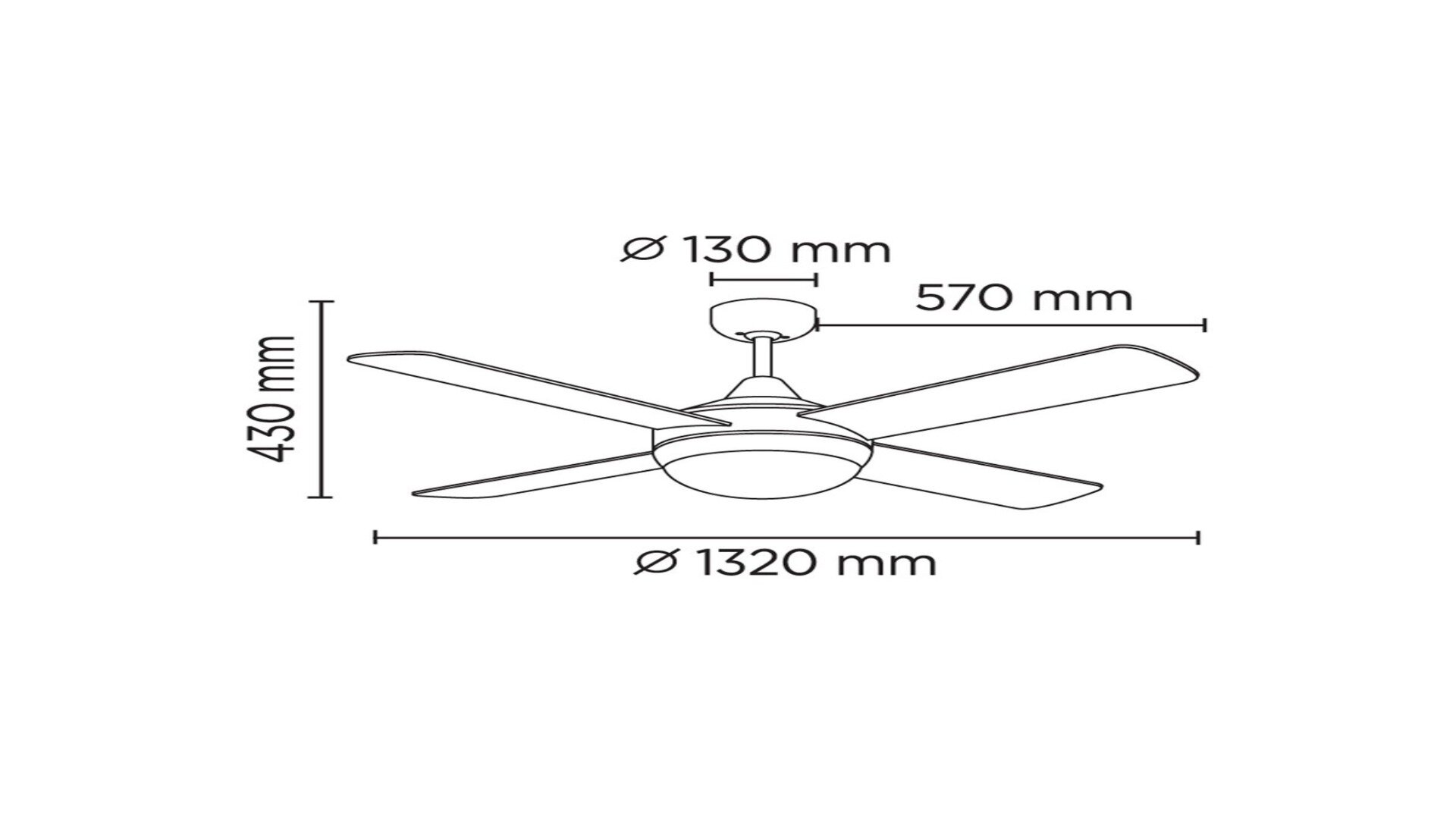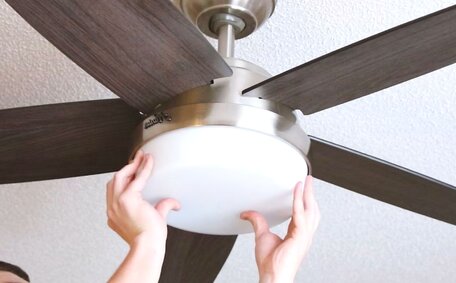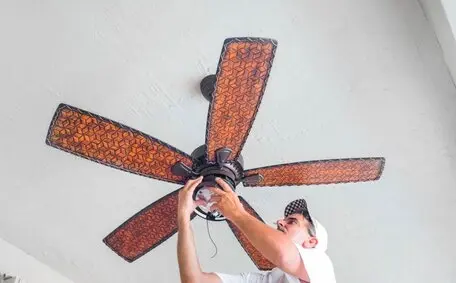Picking the perfect ceiling fan size can sometimes be a bit of a puzzle. With so many sizes to choose from, it’s not uncommon to select one that doesn’t quite match your needs. A fan that’s not the right size won’t move enough air or fit nicely in your room.
This guide helps you select the perfect fan for optimal cooling through simple ceiling fan sizing. We break down small, medium, and large fan categories and show which is best based on your room’s dimensions.
![2023 11 Drawing Ceiling Fan With Light Drawing Ceiling Fan Light]()
Today, most ceiling fans are installed for considerably different purposes—to help homeowners cool themselves down at a fraction of the cost of air conditioning or to add an accent to their home decor. Follow our easy recommendations to install a ceiling fan that precisely fits your space for maximum comfort and efficient airflow.
Ceiling Fan Sizing Basics
Proper ceiling fan sizing starts with the three basic size categories: small, medium, and large. Determining which category your ceiling fan falls into will depend on its diameter in inches.
Small Ceiling Fans (under 106 centimetres)
Smaller ceiling fans are perfect for smaller rooms up to 100 square feet. Their compact design circulates air well in tighter spaces like bedrooms, home offices, and walk-in closets. Look for small fans if your room is below the 100 sqft mark.
![2023 11 3 Bladed Ceiling Fan Brown Bladed Ceiling Fan Brown]()
Medium Ceiling Fans (132 centimetres)
Most rooms between 100 and 144 square feet are suited for a medium 132cm or 52-inch ceiling fan. This standard size effectively cools mid-sized bedrooms, living rooms, and dining areas. A 52-inch fan’s blades can fully move air around this common room size range.
Large Ceiling Fans (over 132 centimetres)
Any space over 144 square feet or those with high vaulted ceilings require a more robust large ceiling fan. The extra-wide blades of a large fan, usually 56 inches or more, efficiently circulate cool breezes throughout large open-concept areas, family rooms, and bonus spaces. They’re also a must for moving adequate air in very tall ceilings.
Understanding these general fan size guidelines helps you quickly figure out which category fits your room’s dimensions best.
Special Circumstances
Although general size categories are useful for standard rooms, some spaces need more thought due to their unique traits. High or vaulted ceilings, for instance, demand fans that efficiently move air across tall vertical areas.
![2023 11 Bed Modern Ceiling Fan Bed Modern Ceiling Fan]()
In such situations, you might need a larger ceiling fan, even if the room’s square footage suggests a smaller size. Uniquely shaped rooms, like those with cathedral ceilings or open-concept areas, can also affect how well air circulates.
When ceilings have multiple sections at different heights, choosing a fan that provides adequate coverage can require measuring and testing blade spans. Depending on the layout, wall-mounted options may also serve these extraordinary spaces better than standard ceiling fans. Constantly evaluate ceiling height, room shape factors, and square footage to ensure your selected fan is up for any circulation challenges specific to your design.
Other Considerations
Besides the size or diameter, there are other things to consider when picking the perfect ceiling fan. For example, more blades usually mean greater airflow, but they might make the fan bigger. And watch out for how integrated light kits could extend the fan’s profile.
![2023 11 Ceiling Fan And Awning Linear Window Above The Bed Ceiling Fan Awning Linear Window Bed]()
It’s worthwhile to consider including lighting and blade options that suit your room’s design needs while still fitting within the appropriately sized category. Energy efficiency ratings are another practical consideration, as higher-rated ceiling fans will efficiently circulate air without high utility costs.
These fans have powerful motors, making them ideal for bigger spaces. Think about attachments, aesthetics , energy use, and basic sizing when choosing to ensure the fan not only fits but also cools and ventilates your room effectively.
FAQs About Ceiling Fan Sizing
Can I use a smaller fan if the room is bigger?
While installing a smaller fan in a larger room is possible, it likely won’t perform as well as the appropriately sized option. A ceiling fan that is too small won’t adequately circulate the entire air volume, resulting in uneven cooling. Some areas may feel pleasant, while others remain stagnant.
You also risk wasting energy trying to compensate without getting the air moving efficiently. In most cases, it’s best to size up rather than down to enjoy optimum airflow throughout the space.
How do I measure fan rotation distance?
The rotation distance or clearance you need refers to the minimum space required between the ceiling fan blades and the floor or objects below for safety and efficient air circulation. To measure, first turn off the power at the breaker.
Then, use a tape measure to calculate the distance from the ceiling to the lowest part of the fan while it’s hanging. Add the manufacturer’s recommended clearance, typically 7-9 feet. If the clearance is higher, add the distance needed so the blades miss people and furnishings by at least 6-7 inches as they spin. This will ensure safe operation and proper ventilation of your ceiling fan.
Get Room Cooling Right with the Perfect Fan Size
We hope this ceiling fan sizing guide has made it easy to determine the ideal size for each room in your home. Correctly matching your ceiling fans to space dimensions is critical for energy-efficient, effective cooling and circulation. Whether you need small, medium or large fans, we’ve provided explicit recommendations to help you choose.
At Bright Force Electrical, our team of experts can help you find the best ceiling fan options to suit your room’s unique characteristics or design needs. We can also help with installation if required.
Please contact us if you have additional questions about ceiling fan sizing or would like help upgrading your home’s fans. We’re ready to ensure you enjoy optimised airflow and comfort from ceiling fans tailored to your specific rooms and budget.












